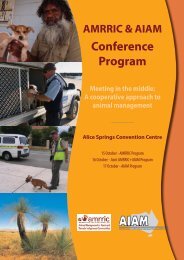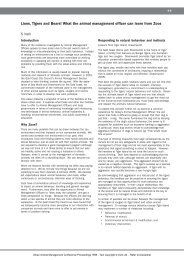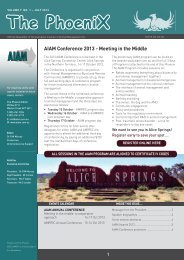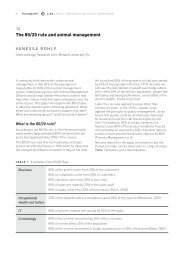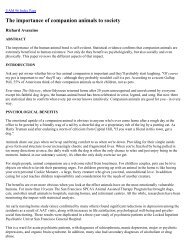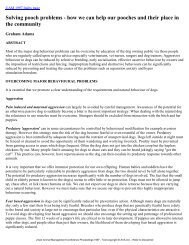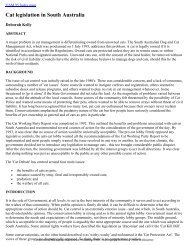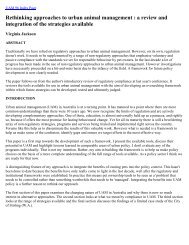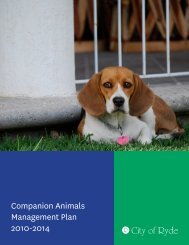Cat management for Magnetic Island - Australian Institute of Animal ...
Cat management for Magnetic Island - Australian Institute of Animal ...
Cat management for Magnetic Island - Australian Institute of Animal ...
You also want an ePaper? Increase the reach of your titles
YUMPU automatically turns print PDFs into web optimized ePapers that Google loves.
MAGNETIC ISLANDThe Townsville suburb <strong>of</strong> <strong>Magnetic</strong> <strong>Island</strong> has a number <strong>of</strong> unique attributes which qualify it as a particularly goodplace to undertake an organised community cat <strong>management</strong> fact finding operation. By 1994 a primafacie case <strong>for</strong> cat<strong>management</strong> on <strong>Magnetic</strong> <strong>Island</strong> existed <strong>for</strong> 3 main reasons:1. An ecologically important program <strong>of</strong> mandatory cat minimisation within the confines <strong>of</strong> the <strong>Magnetic</strong> <strong>Island</strong>National Park depended absolutely on cat control in adjoining residential areas.2. Widespread public concern had arisen on the island about the unlawful, unsanctioned and indiscriminatekilling <strong>of</strong> cats in places other than the National Park.3. The idea <strong>of</strong> cat <strong>management</strong> <strong>for</strong> the <strong>Island</strong>, and even some serious suggestion <strong>of</strong> cat eradication, had been put<strong>for</strong>ward strongly by some (number uncertain) <strong>of</strong> island residents.<strong>Magnetic</strong> <strong>Island</strong> has a human population <strong>of</strong> approximately 2,655 1 . It is an attractive study area because <strong>of</strong> themoderate community size, its National Park, its proximity to the rest <strong>of</strong> Townsville City, its physical separation fromthe mainland part <strong>of</strong> the city and its otherwise normal suburban status.There are 780 private households (400 in owned property and 380 rented) on <strong>Magnetic</strong> <strong>Island</strong>. The census lists another100 households living on boats or other similarly less fixed addresses. At the present time an unknown number <strong>of</strong>stray/feral cats also live on the island.Approximately 54% <strong>of</strong> the island is currently reserved and managed as a National Park by the QueenslandGovernment Department <strong>of</strong> Environment and Heritage. Residential and other <strong>for</strong>ms <strong>of</strong> freehold property almostsurround the <strong>Magnetic</strong> <strong>Island</strong> National Park.After discussing cat issues in the <strong>for</strong>um <strong>of</strong> the Council's Environment Consultative Committee on 10/12/93, thefollowing pathway <strong>for</strong> approaching cat <strong>management</strong> on <strong>Magnetic</strong> <strong>Island</strong> was initiated:1. Review the available literature on the subject <strong>of</strong> cat <strong>management</strong> and community cat problems.2. Prepare an appropriate <strong>management</strong> strategy rationale that is effective and af<strong>for</strong>dable <strong>for</strong> the council.3. Undertake a community survey to gather cat population details, gauge the opinions <strong>of</strong> residents about catissues and gauge acceptance <strong>of</strong> the key elements <strong>of</strong> a suite <strong>of</strong> tentative cat <strong>management</strong> suggestions (from 2).4. Implement a 12 month <strong>management</strong> trial on the basis <strong>of</strong> techniques approved by community feedback from thesurvey.5. Resurvey after approximately 12 months to compare cat population details and assess community impressions<strong>of</strong> the success or otherwise <strong>of</strong> the trial strategy.6. Reflect on the success (or otherwise) <strong>of</strong> the whole <strong>Magnetic</strong> <strong>Island</strong> cat <strong>management</strong> exercise with a view tointroducing an effective cat <strong>management</strong> policy <strong>for</strong> the entire City.1. Review and prepareThe work and the recommendations <strong>of</strong> the authors, Veitch (1991), Upton (1992), Wilson et al (1992), Wood (1992),Duncan (1993), Nattrass (1993), Pergl (1994), Kelly (1995), Penson (1995) and Webb (1995), was helpful indeveloping the cat <strong>management</strong> strategy that is now in place on <strong>Magnetic</strong> <strong>Island</strong>. Particular attention was paid to theSherbrooke experience (Pergl 1994). Every ef<strong>for</strong>t was made to make best use <strong>of</strong> this specific reference because <strong>of</strong> itslocal government ambience and its environmental background.2. Strategy rationalei. Recording pets and removing strays - the only place to startThe question <strong>of</strong> ownership and owner responsibility is central to any attempt at urban cat <strong>management</strong>. While otherissues may apply by way <strong>of</strong> system refinements, the first and most important step is the identification <strong>of</strong> ownership.Once the owner <strong>of</strong> an animal has been <strong>for</strong>mally identified, community expectations relating to reasonable restraint andcare can be encouraged and if necessary en<strong>for</strong>ced.Urban <strong>Animal</strong> Management Conference Proceedings 1997 - Text copyright © AVA Ltd - Refer to Disclaimer




